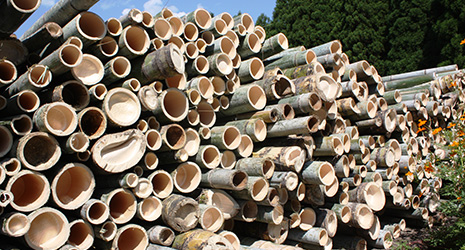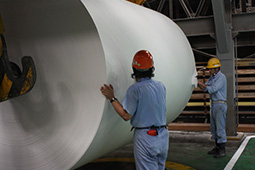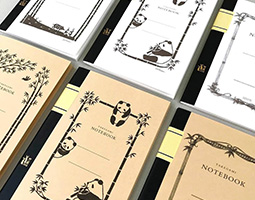August 2022
Making Paper Using Bamboo

Bamboo collected to make bamboo chips -

Bamboo chips, the raw material for bamboo papermaking

A roll of bamboo paper 
100% bamboo paper notebooks 
Origami (paper folding) animals of the satoyama countryside and “memo towers” made from bamboo paper

Bamboo paper is attracting attention as an effective use of bamboo when viewed from the perspective of properly managing Japan’s bamboo forests. One company in Japan in particular is highly committed to the production of this bamboo paper.

In recent years, neglected bamboo forests have become a problem in Japanese farm and mountain villages. Bamboo grows quickly, with its underground stem growing by about three meters annually, thus allowing new bamboo sprouts to grow, these reaching more than ten meters in height in just two to three months. Therefore, if left unmanaged, bamboo forests will spread to surrounding thickets, depriving other plants of sunlight and causing them to wither. If this situation continues, there is even a danger of losing the beautiful landscapes and biodiversity of Japanese satoyama*.
Chuetsu Pulp & Paper Co., Ltd. is working to address this issue by using its own original technology. The company was founded in Takaoka City, Toyama Prefecture in 1947 and is now the only comprehensive pulp and paper manufacturer in Japan that has technology to make paper out of bamboo.
“Japan long consumed bamboo in large quantities as a material for making the frames of baskets, boxes, bamboo fences, and earthen walls, but with the spread of plastic products and changes in lifestyles, bamboo has now become almost unused,” explains Nishimura Osamu, the head of the company’s Sales Planning Department. “I believe that the sustainable use of Japanese bamboo as a resource is a matter of importance for society as a whole.”
Chuetsu Pulp & Paper started making paper using bamboo in 1996. Kagoshima Prefecture, which is the location of the Sendai Mill, one of the company’s paper mills, has the largest surface area of bamboo forest in Japan and is one of Japan’s leading producers of bamboo shoots**. Regional farmers regularly cut down bamboo that has been growing for a few years in order to harvest good-quality bamboo shoots, but disposing of the bamboo has been an issue. Bamboo does not rot easily even if it may wither, which means that it does not easily return to the soil, while burning bamboo to dispose of it is bothersome and causes environmental stress. Consequently, a bamboo shoot farmer asked the person in charge of collecting raw materials at the mill if it would like to use the cut bamboo as raw material for paper.
Chuetsu Pulp & Paper had the farmer take the bamboo to the chip factory and bought it according to its weight.
Nishimura says, “Initially, the blending ratio of the bamboo pulp was 10%, but in 2009, we started making and selling ‘bamboo paper’ from 100% domestic bamboo pulp, setting up a system for collecting up to 20,000 tons of bamboo per year.”

As part of this effort, the company went through a long process of trial and error, such as completely rethinking the blades of the cutting machine at the chip factory to be usable with bamboo. Finally, it was able to succeed in making bamboo chips suitable for papermaking.
Bamboo paper has a supple and gentle feel, with original products such as notebooks, sticky notes, letter sets, and calendars made from it becoming very popular. Moreover, as a product that contributes to solving social issues such as that of neglected bamboo forests, bamboo paper has won numerous awards, including the “Eco-Products Grand Prize.”


Neglected bamboo forests are spreading all over the country, and the technology of making bamboo paper is expected to contribute to the protection of Japan's satoyama while making effective use of bamboo.
* “An area consisting of farmlands, irrigation ponds, secondary forest, plantation forest, and grasslands around human settlements” (Ministry of the Environment, Japan).
** Bamboo shoots are edible. See here on bamboo shoot cuisine.

